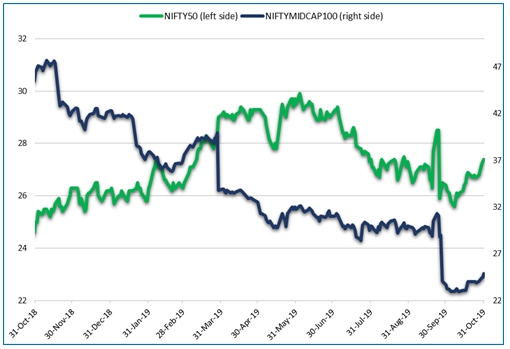The recent green trail of the Indian equity has led the S&P BSE Sensex and Nifty 50 to a record high with both currently sailing over a 40,000 and 11,700 mark, respectively, reflecting buoyant market sentiment.
Some of the abetting factors have been:
- Withdrawal of higher surcharge levied by Finance (No. 2) Act, 2019 on long/short term gains arising from the transfer of equity shares/units
- Withdrawal of angel tax provisions for start-ups and their investors
- The announcement by the government to infuse capital worth Rs 70,000 crore into PSU banks for credit growth
- Government’s decision to merge 21 PSU Banks into 12 to facilitate efficient use of capital
- The government making available Rs 10,000 crore special window to provide funding for housing projects
- Loan melas in 400 districts to push credit off-take and consumption
- Slashing corporate tax rate rates across companies enabling them to compete with Asian peers
- Encouraging Q2FY20 corporate earnings of some companies
- Festive season helping demand – particularly in the auto and consumer durable space
- RBI being accommodative in its monetary policy actions and having cut rates (by 135 basis points since February 2019) to address growth concerns
- Above-normal southwest monsoon
- Possibility that the government may offer tax sops by doing away with Dividend Distribution Tax (DDT), Securities Transaction Tax (STT), and perhaps rejig Long Term Capital Gain Tax
- Also, global cues – particularly the US Federal Reserve lowering interest, US-China trade tensions easing and a limited surge in international oil price (due to softer demand) have proved supportive for Indian equities
Over the last one-half-months, Foreign Portfolio Investors (FPI) and domestic mutual funds have shown spirited buying in Indian equities buoyed by the factors listed above.
That being said, the improved sentiments in the Indian equity market perhaps holds true for short-term or near term. Why? For one, India’s economy is slowing down and appears to have stuck in the rut. To come out of it and clock high growth as the country aspires to be US$ 5 trillion economy by 2024-25, effective implementation of reforms, ensuring the policy environment, in general, is enabling, creating enough jobs, and boosting exports will be the key.
Graph: How are valuations looking?

Past performance may or may not be sustained in the future
Data as on October 31, 2019
(Source: NSE)
In the last one year we have moved up but with earnings of certain companies catching up (albeit from a low base), beaten street estimates and are now projected to do better. It is not that the margin of safety is absent at the market peak; there are still certain value buy opportunities––particularly in the mid-cap space.
But it would not be too wise to get swayed by the forward earnings estimates which look to be amplified. For several years, the market has initially projected an ambitious earnings growth but the actual growth has turned out to be lower. If encouraging Q2FY20 earnings do not continue, it could upset the market.
Hence, it is important for financial advisers to devise a sensible investment strategy. The impact of corporate earnings on the investors’/clients’ mutual fund portfolio would be hinged on the portfolio characteristics of the schemes suggested to them.
A “Core and Satellite” approach to build a portfolio of equity-oriented mutual fund schemes can offer investors best of both worlds, i.e. short-term high-rewarding opportunities and long-term steady-return investing. It is a time-tested investment strategy followed by some of the most successful investors to build a portfolio.
Which type of equity-oriented schemes to consider?
The term “core” applies to the more stable, long-term holdings of the portfolio while the term “satellite” applies to the strategic portion that would help push up the overall returns of the portfolio across market conditions.
Core holdings should form a major portion of the mutual fund portfolio and ideally should consist of a large-cap fund, multi-cap fund and a value style fund.
The rest, say around 35-40%, can be “satellite” holdings consisting of a mid-cap fund, large & mid-cap fund and an aggressive hybrid fund. If the investor is willing to take the risk, a small portion could be allocated to small-cap as well in the satellite holding.
Remember, the art of cleverly structuring the portfolio by assigning weights to each category of mutual funds and the schemes picked for the portfolio is extremely important so that the investor can clock optimal risk-adjusted returns. And it is important to set realistic post-tax return expectations.
In an overvalued equity market, financial advisers cannot go all out and recommend clients that they invest in mid-and small-caps or invest in an ad hoc manner based on current euphoria or news flows or when investors get blinded by the supernormal market returns. The investor might end up burning his fingers.
Do not go gung-ho when advising equity mutual funds, particularly when the market continues scaling new highs. Devising a sensible strategy and astutely constructing the mutual fund portfolio with thorough research & analysis (based on quantitative and qualitative parameters) to create a strategic portfolio is essential. Moreover, with the change in market outlook, the allocations/weights to each type of fund needs to be revisited, especially in 'Satellite' holdings. Unless that is done, clocking superior inflation-beating returns over the long-term may be a challenge.
While there is a sense of optimism about India's future growth, there are headwinds at play as well. For the market to move higher, the positives need to outweigh the negatives. That being said, the long-term outlook for India is not gloomy. As ethical, unbiased, and prudent financial advisers, recommend worthy mutual fund schemes based on the investor’s investment objectives, financial goals, their risk profile and time horizon before goals befall.
Jimmy A Patel is MD & CEO Quantum Mutual Fund. The views expressed in this article are solely of the author and do not necessarily reflect the views of Cafemutual.






